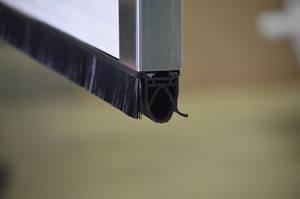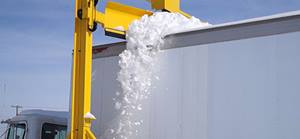- Home
- News
- Preparing Your Loading Docks for Winter
Preparing Your Loading Docks for Winter
In northern geographies and colder climates, the winter can wreak havoc not only inside loading dock areas but also across the approach and yard. Temperature control becomes more difficult, and snow and ice that accumulate in these exterior spaces can be tracked or pushed into the facility—creating slip hazards for workers and potential damage to products and equipment.
Let’s look at some of the biggest culprits of energy loss and safety risks associated with winter weather across the loading dock, approach, and yard.
Light Means Trouble for Environmental Control at the Loading Dock
Any light that is visible through gaps between a secured trailer and the loading dock door means outside air and elements can get inside. Snow, cold, rain and ice can – and will – sneak through these openings and create problems for loading dock workers and the materials they handle.
Additionally, the warm conditioned air inside the loading dock can leak out of the facility, causing HVAC systems to run harder than necessary to make up for the heat loss. It’s no coincidence that energy usage often soars during the winter months in colder climates.
Before any solutions can be considered for these potentially costly and hazardous gaps, it’s important to see exactly where light (and any outdoor elements) are coming through.
Common Gaps at a Loading Dock Opening:
Fortunately, these gaps are fairly obvious and often predictable in location. They are:
- Along both sides of the trailer (often in trailer door hinge gaps)
- At the top of the trailer
- Below and around the loading dock leveler and dock bumpers
Once these gaps are identified, the right solutions can be evaluated.
The Right All-Weather Equipment
Loading Dock Seals and Shelters
In some cases, it’s just a matter of replacing old or worn-out sealing products. Eventually, loading dock seals, shelters, and filler pads diminish to the point of being ineffective. Fortunately, there are some easy-to-find replacements or upgrades that can perform admirably.
Depending on the application, a loading dock seal or shelter can help provide valuable sealing power along the sides and tops of most loading dock openings. It is estimated that sealing air gaps at the loading dock can help save up to $5,000 annually per dock position. Additional products can help seal the “fourth side” of the loading dock opening near the floor, such as under-leveler seals.

Loading Dock Weather Seals
Performing an inspection on your exterior door seals and cycle times will also help you prepare your facility for colder temperatures. Each loading dock door opening represents a giant hole in the wall of your facility. Strung together, these dock openings present an enormous opportunity for heating energy to escape – not to mention allowing rain/snow, dirt and pests to get in. Improving your loading dock door weather seals can help save up to $7,000 annually per door opening.

High Volume, Low Speed (HVLS) Fans
Other things to consider while preparing your facility for winter include improving interior air movement. By adding HVLS industrial ceiling fans to your facility, you can help save 20-30% on heating costs per year. The fans are designed to circulate a large amount of air in a process known as destratification. This process mixes warm air from the ceiling with cooler air at the floor, to even the temperature throughout the space.

Scraper Systems™ Snow Removal Systems
When your business relies on your truck fleet getting on the road quickly and safely after a snowfall, automated snow removal systems are vital. Designed for fast, efficient and low-maintenance snow removal, even in the harshest of winter conditions, Scraper Systems fleet plows clear snow from your fleet in less than 30 seconds per vehicle, up to 60 vehicles per hour.

Lok-Vu™ Visual Lock Verification System
Help reduce the need to place workers on the dangerous, wintery drive approach. Displayed on an interior monitor, Lok-Vu uses an exterior camera which is available as single or dual, to help confirm a RIG- or wheel-based vehicle restraint is securely engaged to the loading dock along with verifying trailer stand presence in the case of dropped trailers.

Loading Dock Safety in the Winter
It’s important to consider both warehouse workers’ and truck drivers’ safety when preparing for the cold winter months. Cold air, snow, and ice create hazards which can be planned for and prevented.
- Keep areas of high traffic clean, especially the loading zone
- Prevent slippery situations by mopping snow or ice and using non-slip safety mats
- Gauge general lighting and signal lighting because the winter months are darker for longer hours and snow may accumulate on communication units
- Take additional precautions to keep inclines clear of snow and ice
- Be aware that rubber wheel chocks often slip on icy surfaces -- employ durable and reliable vehicle restraints to help prevent trailer creep, amongst other trailer separation accidents, and always use safety brakes in the winter. Keep in mind, there are vehicle restraints that are best suited for areas that see a lot of snow.
Prepare Your Loading Dock for Winter
Make sure no light – and thus weather – is getting inside the loading dock by examining your loading dock door openings. Once gaps have been discovered, ensure they’re eliminated by installing proper equipment. Then, consider other areas of the facility that might benefit from the installation of industrial fans or snow removal systems. At Rite-Hite, we have trained representatives who can perform an audit on your facility for energy improvements. They can help identify areas in your warehouse or distribution center that are prone to energy loss. For help getting started on winterizing your loading dock, contact Rite-Hite for a site survey.
Contact Us Find a Rep